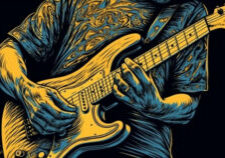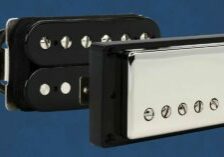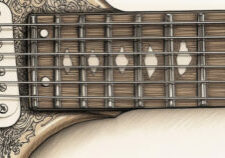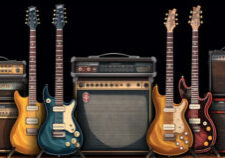Are you looking to expand your knowledge of guitar parts? In this article, we’ll go over the names and functions of various components found electric guitars.
From the headstock to the tuners, from the pickups to the bridge, we’ll explore the essential elements that make up the instrument.
Whether you’re a beginner or an experienced player, understanding these parts will enhance your playing experience. So, grab your guitar and let’s dive in!
Guitar Parts Image
For the most part, electric guitar parts are going to be the same, but the location of different parts will change based on the guitar.
Here is an image that shows the common guitar parts and location on a Fender Stratocaster-style guitar.
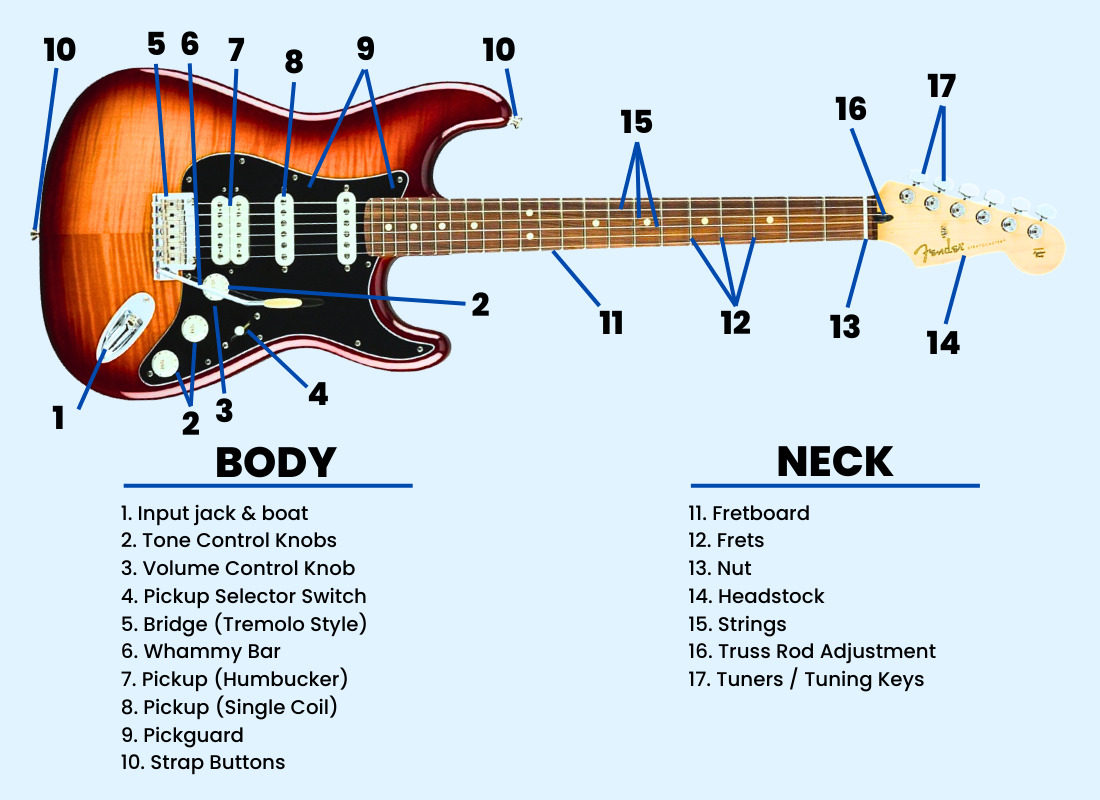
electric guitar parts
Input Jack & Wiring
The input jack is the part of the guitar where you plug in your cable to connect to an amplifier or other audio equipment. It is usually located on the lower edge of the guitar body. On a Fender strat the jack boat is installed on the top of the guitar towards the lower end.
When you want to play your guitar through an amplifier, you simply insert one end of the cable into the input jack and the other end into the amplifier. This allows the electrical signal from the strings to be transmitted through the cable and into the amplifier, which then amplifies the sound and projects it through the speakers.
Tone & Volume Controls
Volume and tone controls on electric guitars allow you to adjust the output level and shape the sound to your liking. These controls are located below the strings and give you the ability to enhance the versatility of your guitar’s sound.
By adjusting the volume control, you can increase or decrease the overall output level of your guitar, allowing you to be louder or quieter depending on your preference or the needs of the situation. The tone control, on the other hand, allows you to adjust the sound characteristics of your guitar. You can make it brighter or warmer, depending on your desired tone.
Pickup Selector Switch
By adjusting the pickup selector switch on electric guitars, you can choose which pickups to use, allowing you to alter the sound and control the output of your guitar’s pickups.
The pickup selector switch is a toggle switch that is typically located near the volume and tone knobs on the body of the guitar. It allows you to switch between different pickups or combinations of pickups.
For example, if your guitar has multiple pickups, you can use just the bridge pickup for a bright and biting tone or the neck pickup for a warmer and mellower sound.
Controls and Switches Are Different on Each Model
Some guitars have different number of control knobs or use a different type of switch. Strats typically come with 3 pickups, a 5-way pickup selector switch and 3 control knows. A Less Paul normally includes 2 humbucker pickups, a 2-way pickup selector switch, and 4 control knobs.
You might see only 1 volume control in a guitar with a single pickup guitar and up to 5 knobs in other guitars. Some guitars will also use a push-pull knob to switch on one of the knows to change how the pickup coils are split.
The photo below is from my Gibson SG which has the typical 2-way pickup selector switch to go from Rhythm (neck) to the Treble (Bridge), then 4 control knobs (2 for volume, 2 for tone), and the input jack on the from body without a jack boat.
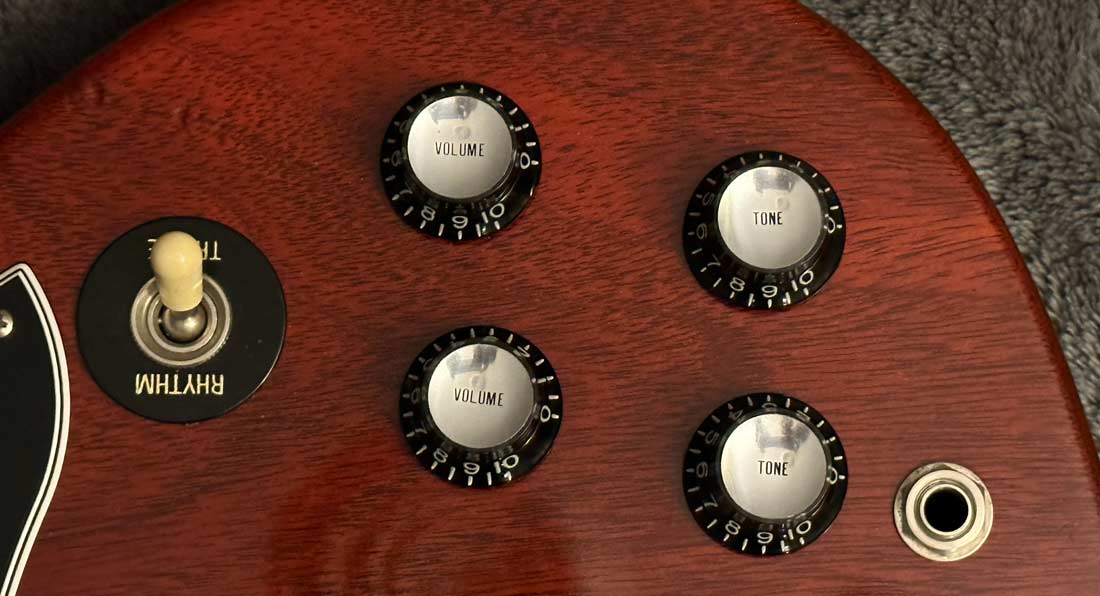
control knobs and pickup selector on Gibson SG
Bridge, Tremelo, & Whammy Bar
The electric guitar bridge serves as a connection point between the strings and the body, providing stability, support, and control over various aspects of the guitar’s performance.
In terms of stability, the bridge is responsible for securing the strings in place and maintaining tension, ensuring that they remain firmly attached to the guitar. This stability is vital for accurate tuning and precise intonation, allowing the player to produce harmonically accurate notes and chords across the entire fretboard.
Furthermore, the bridge also contributes to the guitar’s sustain and resonance. As the strings are anchored to the bridge, their vibrations are transferred through the bridge to the body, effectively amplifying the sound and creating sustain. Different types of bridges, such as fixed bridges, tremolo bridges, or vibrato bridges, offer various methods of adjusting the tension and enhancing the instrument’s tonal characteristics.
Additionally, the bridge plays a crucial role in adjusting the guitar’s action, which refers to the height of the strings above the fretboard. Moreover, the electric guitar bridge often integrates individual saddles for each string. These adjustable saddles allow players to fine-tune the intonation of each string, ensuring that every note played is in tune across all frets. This precise intonation is especially important for guitarists who frequently use open tunings or play complex chords and melodies.
Furthermore, some electric guitar bridges, like the Strat bridge we see here offer additional features, such as tremolo systems or whammy bars. These mechanisms enable players to create unique pitch-bending effects, adding expressive possibilities to their playing style. One of the more common and popular bridges is called the Floyd Rose.
Overall, the electric guitar bridge is a fundamental part of the instrument’s design, significantly impacting its playability, tone, and versatility.
Humbucker Pickup
If you want a fuller and warmer tone, consider installing a humbucker pickup on your electric guitar.
A humbucker pickup is a type of pickup that consists of two coils wired together to cancel out the hum and noise often associated with single-coil pickups. This design results in a thicker and more powerful sound, making it ideal for genres like rock, blues, and heavy metal.
Humbuckers are known for their ability to produce a smooth and creamy tone with enhanced sustain. They also have a higher output compared to single-coil pickups, which means they can drive your amplifier harder and produce more distortion if desired.
Single Coil Pickup
The single coil pickup is known for its bright and twangy tone, making it a popular choice for genres like country and surf rock. If you’re looking for that classic vintage sound, the single coil pickup is the way to go.
It’s characterized by its clear and articulate sound, with a crisp attack and plenty of sparkle. Whether you’re playing clean melodies or dialing up some overdrive for a gritty bluesy tone, the single coil pickup delivers.
And if you’re a fan of those twangy country licks or want to channel your inner Dick Dale, the single coil pickup has got you covered. So if you’re after that iconic sound that’s been heard on countless recordings, grab a guitar with a single coil pickup and start playing those unforgettable riffs.
Other Pickups
Now that you’ve learned about single coil pickups, let’s explore some other types of pickups commonly found in electric guitars.
One popular option is the humbucker pickup. As the name suggests, it helps reduce the hum or noise often associated with single coil pickups. Humbuckers use two coils that are wired in opposite directions, canceling out unwanted noise and producing a warmer and thicker tone.
Another type is the P90 pickup, which is known for its distinct and gritty sound. It falls between the clarity of single coils and the power of humbuckers. P90 pickups provide a fat and punchy tone, making them a favorite among blues and rock guitarists.
Pick Guard / Scratchplate
One important component of an electric guitar is the pickguard, which serves to protect the body and add a decorative touch.
The pickguard is a piece of material, often made of plastic or other durable materials, that is attached to the body of the guitar, just below the sound hole or pickups.
Its primary function is to shield the body of the guitar from scratches, dings, and other damage that can occur from strumming or picking the strings. Additionally, the pick guard can also serve as a canvas for artistic designs or patterns, adding a visual element to the overall appearance of the guitar.
On the Stratocaster style guitar, the pickguard is used to house the electronics and pickups. This makes it easy to for guitarists to switch out pickguard to change the sound of their guitar.
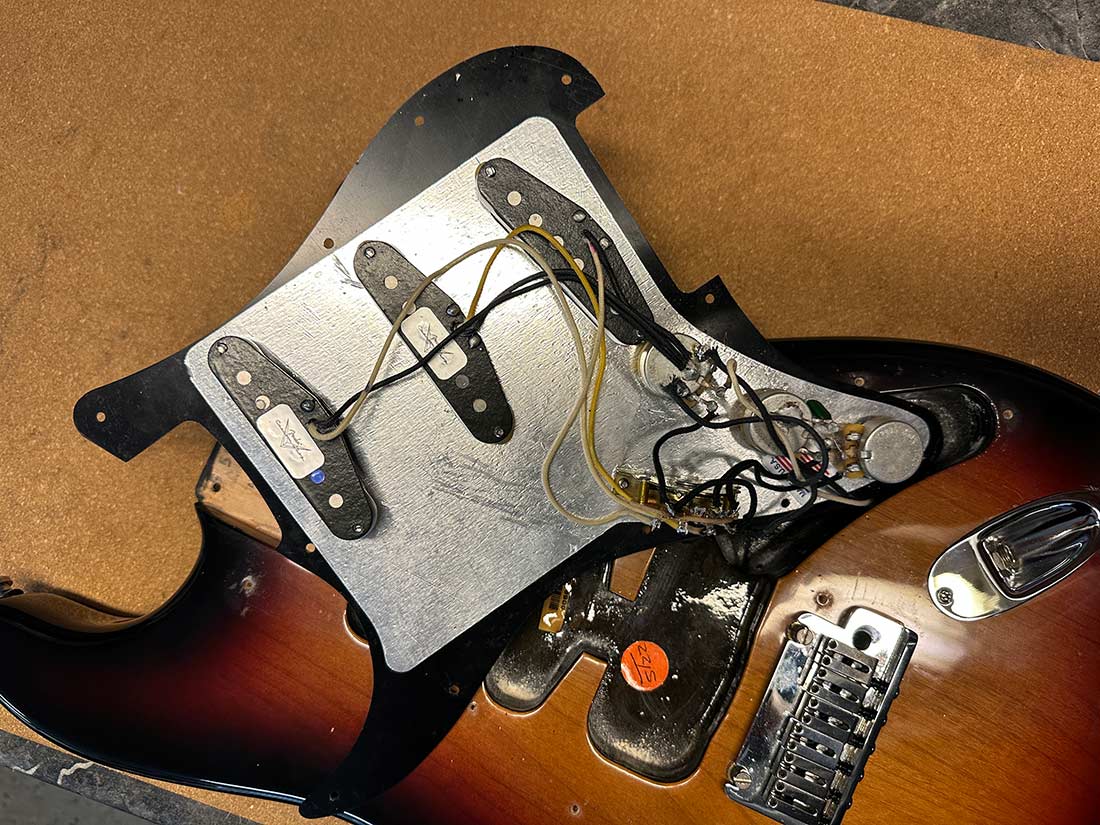
electric guitar pickguard electronics on a Fender Stratocaster
Strap Buttons
Strap buttons are used to securely attach your strap to the strap buttons on the body. These buttons are specifically designed to hold the weight of the guitar and provide stability while you play.
To attach your strap, simply loop one end of the strap through the top button and the other end through the bottom button. Pull the strap tight and double-check that it is securely fastened before you start playing. This will prevent any accidents or mishaps while you’re rocking out.
You can also get locking strap buttons that have a mechanism that allows you to quickly snap on your straps but keep them locked so they don’t fall off when you are on stage, which is handy for gigging guitarists.
Fretboard & Frets
To play different notes on the guitar, press down on the fretboard behind the desired fret with your fingers. The fretboard is the front face of the neck, and it is where the strings run along. It is separated by frets, which are vertical bars that divide the fretboard into different sections.
Each fret position produces a different note when the strings are pressed down behind them. By placing your fingers in the correct position on the fretboard, you can create a variety of melodies and chords. The frets act as guides, allowing you to accurately play the desired notes.
Remember to press down firmly enough to produce a clear sound, but not too hard to cause the strings to go out of tune.
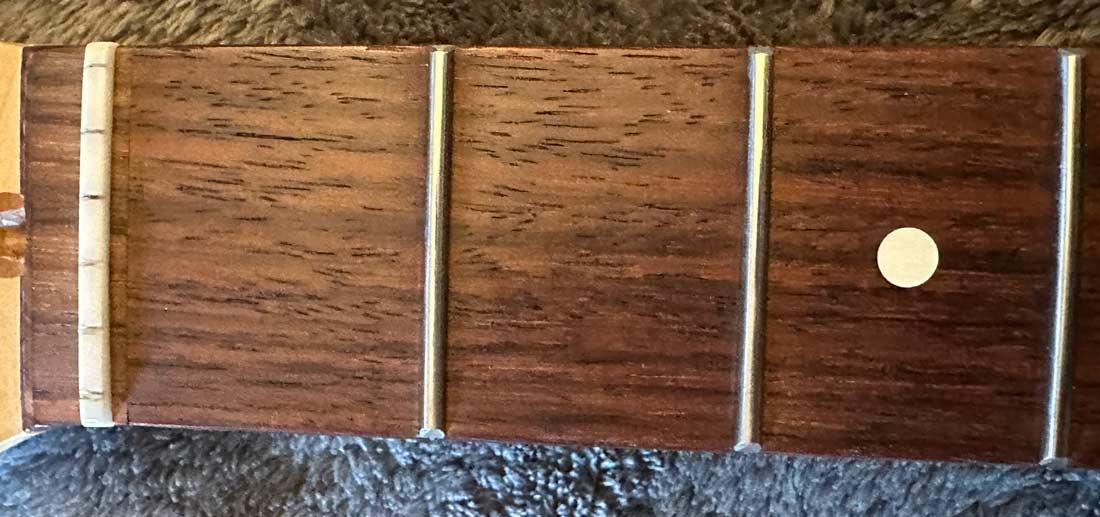
closeup of neck fretboard frets and nut on electric guitar
Nut
The nut, usually made of wood, is located before the headstock and contains grooves for the strings to keep them aligned and separated, ensuring proper string tension. It plays a crucial role in the overall performance of your guitar.
When you play a note, the strings vibrate and pass over the nut, creating a clear and distinct sound. The grooves in the nut help to keep the strings in place and prevent them from sliding around or buzzing against each other. This ensures that each string has the correct amount of tension, allowing for accurate intonation and smooth playing.
It’s important to keep the nut in good condition and properly lubricated to maintain optimal string action and playability.
Headstock
The headstock, often displaying the manufacturer’s name, is where the strings run to and the tuning pegs are located. It’s an essential part of the guitar that plays a crucial role in maintaining the proper tension and tuning of the strings.
The tuning pegs, also known as machine heads, protrude from the headstock and are used to adjust the pitch of the strings. They allow you to tighten or loosen the strings to achieve the desired sound.
The headstock not only serves a functional purpose but also adds to the aesthetic appeal of the guitar with its unique design and branding. So next time you pick up your guitar, take a moment to appreciate the importance of the headstock and tuning pegs in creating beautiful music.
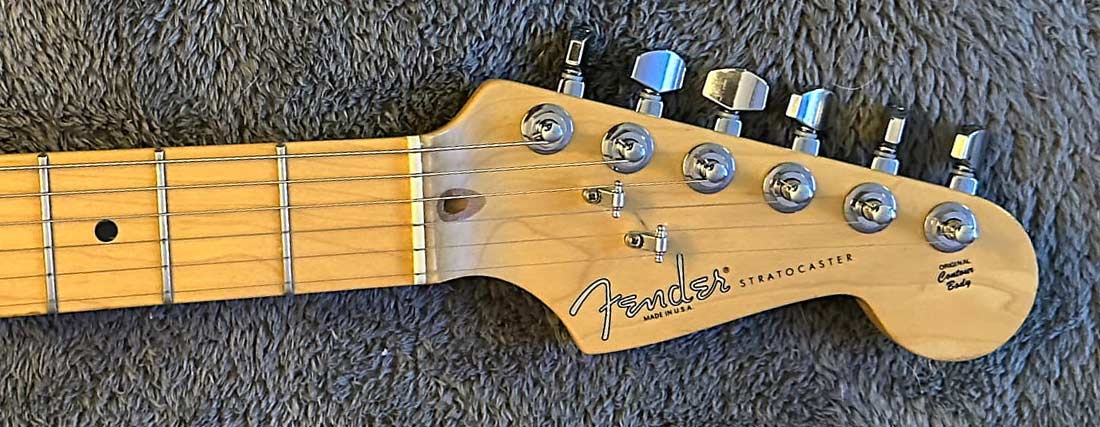
electric guitar headstock
Strings
By now, I expect we know what the strings do. The big thing about strings is just deciding what size you want to play. The size is known as “string guage,”
Lighter gauge strings are easier to bend and play, making them ideal for beginners or those who prefer a more delicate touch.
On the other hand, heavier gauge strings produce a fuller, richer tone and are better suited for players who like to strum aggressively or play with a lot of power.
Experimenting with different gauges can help you find the perfect balance between playability and tone for your unique style.
Truss Rod Adjustment
A truss rod is a metal rod embedded within the neck, running along its length. The primary function of a truss rod is to counteract the tension exerted on the neck by the strings. As the strings are tightened, they exert a force that can cause the neck to bend or bow, resulting in undesirable changes in the guitar’s playability and intonation.
The truss rod, when properly adjusted, can help maintain the neck’s stability and ensure a straight and playable neck. By tightening or loosening the truss rod, guitarists can modify the neck’s relief, which refers to the slight curvature of the neck, allowing for personal preferences in terms of playability and string action.
To properly adjust the truss rod on your guitar, you’ll need the appropriate tools and a careful understanding of the process. This is generally not something that beginners should worry about, you can leave it to your guitar tech as this often comes into play with a guitar setup.
Tuners, Tuning Pegs
Tuners and tuning pegs are used to control the tension, pitch, and tone of the strings on a guitar. When you want to tune your guitar, you turn the tuning pegs to tighten or loosen the strings. By doing this, you can adjust the pitch of each string to the desired note.
Tuning pegs are essential for keeping your guitar in tune and ensuring that each string has the correct tension. They come in various styles, such as open-gear or enclosed, and can be found on the headstock of the guitar.
It is becoming more common to see locking tuners installed on electric guitars. This lets you run the string through the pegs then tighten them up so you don’ have to make so many winds around the peg. Locking tuners make it faster to change strings.
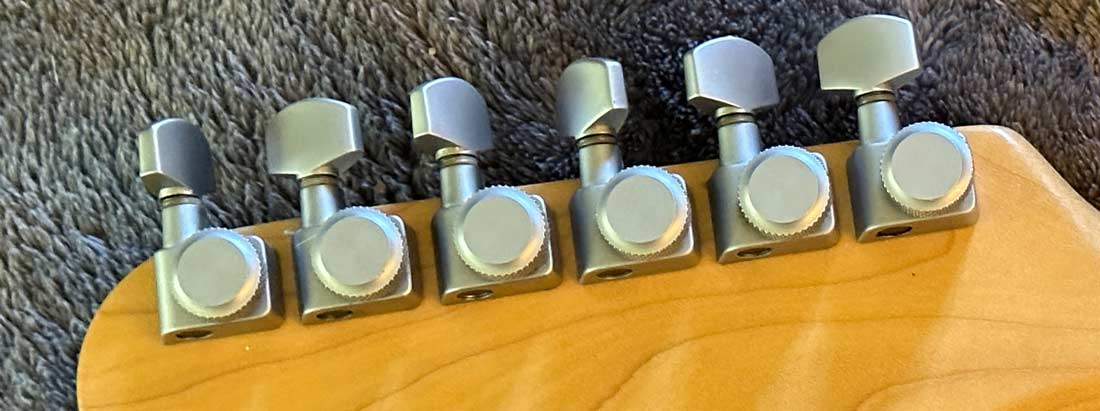
guitar locking tuners
Conclusion
Understanding these components is certainly helpful for any guitar player, whether you’re a beginner or more advanced.
Knowing the names and functions of guitar parts, you’ll be better equipped to navigate your instrument and make any necessary adjustments. It helps to be able to identify the parts when start buying replacements or upgrading your guitar.
But a word to the wise. It’s easy to get carried away dumping money into a guitar on new parts and you often don’t get that money back when you go to sell. But us guitarists do it anyway!

